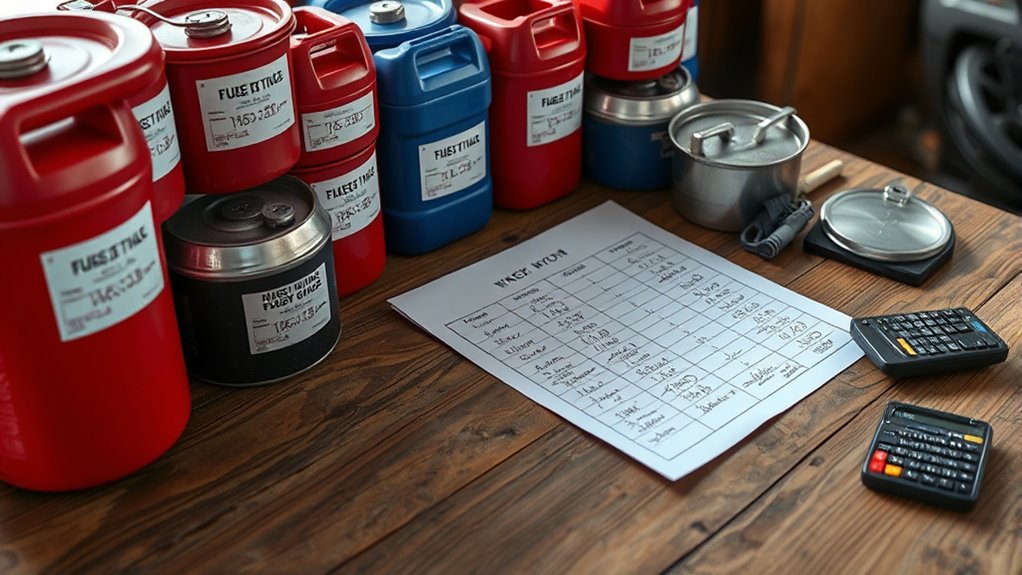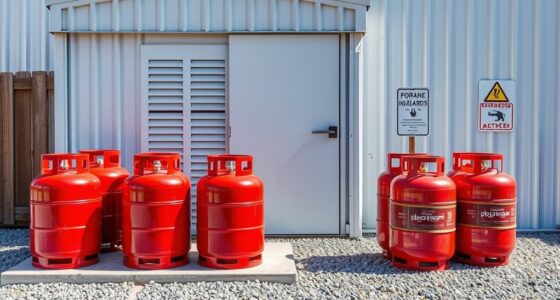To estimate fuel needs for a week-long outage, start by listing all essential devices, determine their total watts, and include surge demands. Calculate your generator’s daily fuel consumption based on its load and specific fuel consumption rates. Add a safety margin—around 50%—to account for unexpected needs and delays. Consider your fuel storage capacity and regulations. For more precise planning, explore tools and guidelines that help refine your estimates and make sure you’re prepared.
Key Takeaways
- List all critical equipment and their wattages, including surge demands, to determine total power needs during the outage.
- Calculate daily fuel consumption by multiplying the generator’s load (kW) by its specific fuel consumption rate (L/kWh).
- Estimate total outage duration and add a safety margin (50%) to account for unforeseen delays and inefficiencies.
- Determine daily fuel requirements and multiply by the number of days to establish your weekly fuel stockpile.
- Include fuel used for routine maintenance and storage considerations, ensuring enough reserve for the entire outage period.
Assessing Your Power Requirements and Load Management
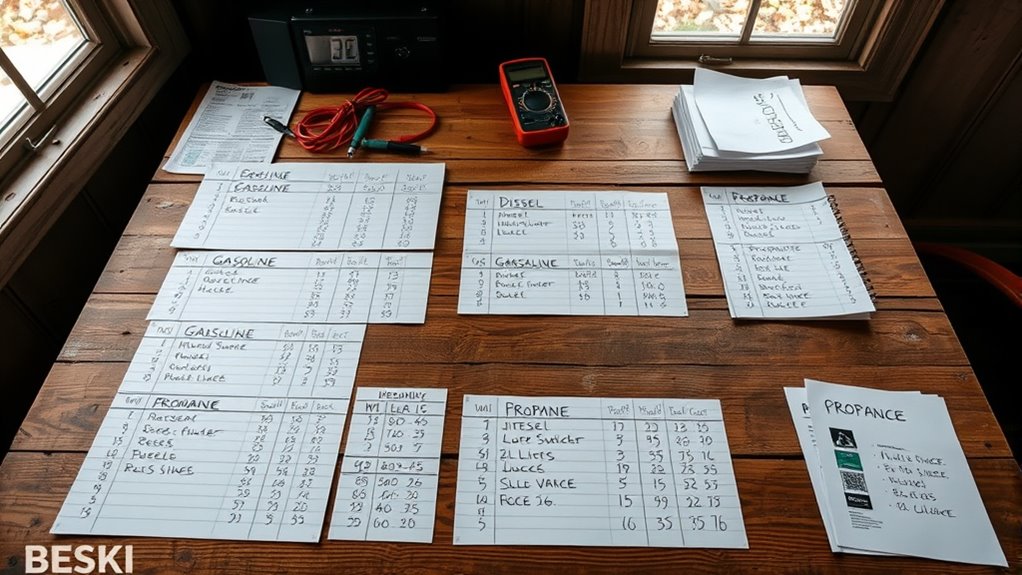
To effectively manage your power during a week-long outage, you need to start by evaluating your actual energy requirements. Begin by listing all essential devices and systems you’ll need, distinguishing critical loads from non-essential ones. Sum the wattages of these critical items, including surge wattages for motors and compressors, which can be much higher during startup. Account for peak demands and daily operational cycles to prevent underestimating your needs. It’s also wise to include contingency loads for unexpected equipment or future needs. Managing your load effectively involves scheduling non-critical tasks during off-peak hours, shifting energy use to reduce peak demands, and selectively turning off less important equipment. This careful assessment ensures your fuel resources are allocated efficiently, keeping your outage plan reliable and sustainable. Proper load management can significantly reduce fuel consumption and extend the duration of your power supply. Additionally, understanding the power requirements of each device helps prevent overloads and ensures your generator operates within safe limits.
Calculating Daily Fuel Consumption Based on Generator Specifications

Understanding how to calculate your daily fuel consumption based on generator specifications is essential for planning an outage. First, determine your generator’s rated kW output or expected average load. Next, find the specific fuel consumption (SFC) from manufacturer data or field tests, typically between 0.2 and 0.4 L/kWh. Multiply your load (kW) by the SFC to get hourly fuel use. For example, at 200 kW with an SFC of 0.25 L/kWh, your generator consumes 50 liters per hour. Then, multiply by the number of operational hours per day. Accurate fuel estimation is crucial for budgeting and ensuring sufficient supply during the outage. Incorporating sound design principles can help visualize data trends or create instructional content related to fuel management. Additionally, accounting for load fluctuations and idle periods can help prevent underestimating fuel needs. Considering generator efficiency can further refine your estimates to match real-world performance. Remember to add a margin for load fluctuations and idle periods. This approach gives you an accurate daily fuel estimate, which you can scale for the entire outage duration.
Planning Fuel Stockpiles and Incorporating Safety Margins
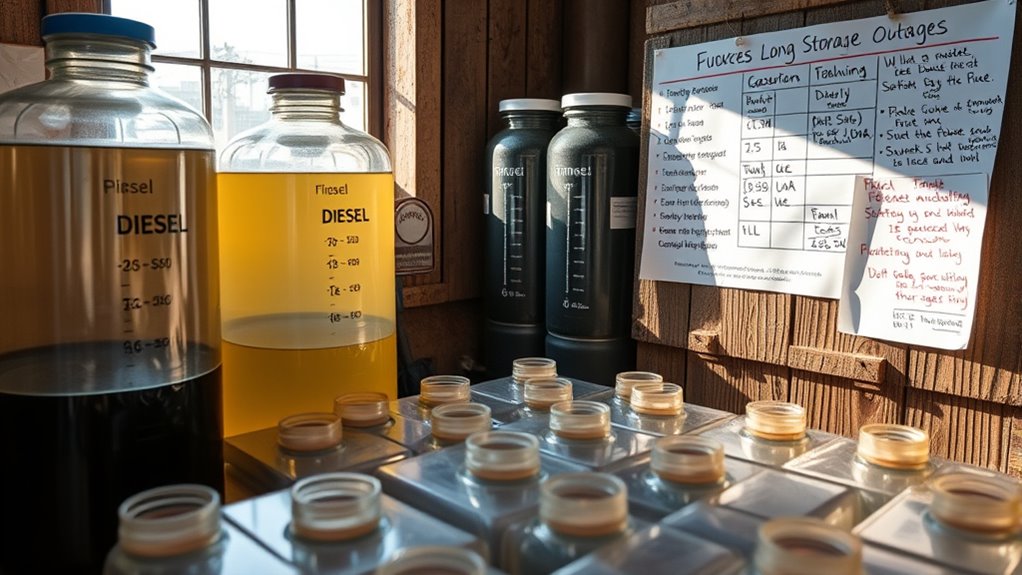
Planning your fuel stockpiles requires incorporating safety margins that account for potential delays, unexpected extensions, and consumption variations. Start by estimating the outage duration based on historical data, then add a 50% contingency buffer to cover unforeseen delays or increased fuel use. For small generators, stockpile at least 25-30 gallons per unit, while large diesel generators should have a minimum of three days’ worth of fuel—around 10,000 gallons for a 2 MW setup—per regulatory guidelines. Remember to include fuel used during routine maintenance. Incorporate safety margins to offset inefficiencies, load management changes, and logistical delays. Ensure your storage volume allows for practical refilling, and use stabilizers to preserve fuel quality. Proper planning and safety margins help secure reliable power during extended outages. Additionally, understanding fuel storage safety and proper handling is crucial to prevent accidents and ensure compliance with safety standards.
Utilizing Tools and Calculators for Precise Fuel Estimation

Utilizing tools and calculators for precise fuel estimation empowers you to determine your exact fuel needs during an outage. These tools use key inputs like generator size, load factor, runtime hours, and fuel consumption rate to generate accurate estimates. Here are four essential insights:
- They help you calculate daily fuel consumption based on your generator’s specifics.
- They allow you to project weekly fuel requirements, ensuring sufficient stockpiles.
- They assess runtime durations for critical systems, guiding refueling schedules.
- They support optimizing generator sizing to balance fuel efficiency and power needs.
- Incorporating considerations like color accuracy and skin health can help prevent damage during outdoor activities.
Considering Fuel Types, Storage Safety, and Regulatory Guidelines
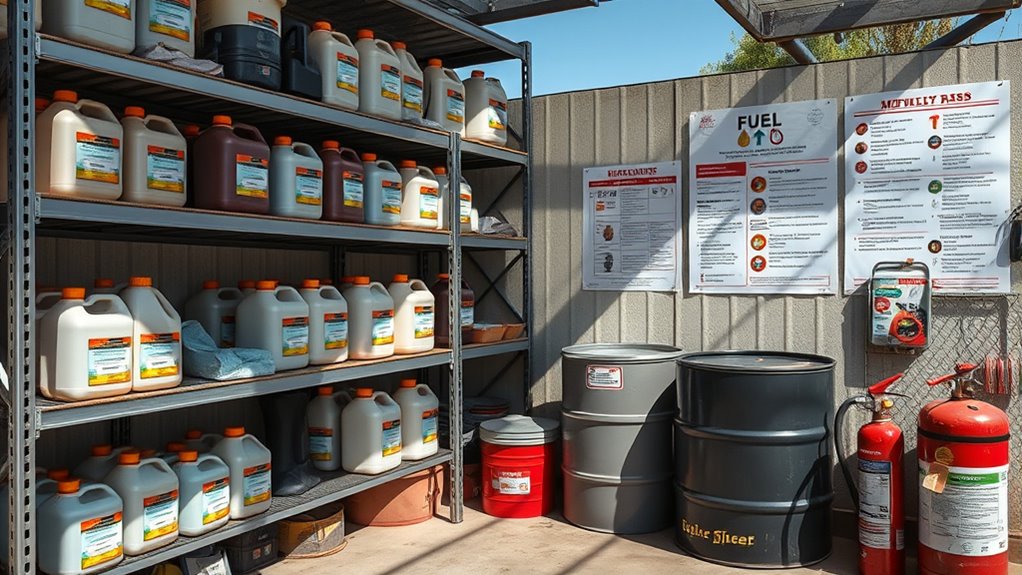
Choosing the right fuel type and guaranteeing safe storage are essential steps in preparing for a week-long outage. Your options include gasoline, diesel, propane, natural gas, or a combination like bi-fuel and dual-fuel systems. Diesel is ideal for critical operations due to its high efficiency and onsite storage benefits, but it needs proper treatment to prevent degradation. Propane offers a long shelf-life and clean-burning benefits, stored safely in pressurized tanks, reducing maintenance concerns. Gasoline is volatile and short-lived, requiring careful, ventilated storage away from ignition sources. Natural gas, supplied via pipelines, minimizes storage needs but can be disrupted during disasters. Always follow safety regulations, fire codes, and environmental guidelines to prevent accidents and ensure compliance. Proper fuel selection and storage safety are crucial for reliable outage management. Additionally, understanding the fuel storage guidelines can help prevent leaks, spills, and other hazards during emergency situations. Maintaining an appropriate fuel quality is also vital to ensure safe and efficient operation of emergency equipment. According to the Security Zone Info, implementing security measures around fuel storage areas can also prevent theft or sabotage during emergencies.
Frequently Asked Questions
How Can I Estimate Fuel Needs for Multiple Generators Running Simultaneously?
To estimate fuel needs for multiple generators running simultaneously, first determine each generator’s rated power and load percentage. Calculate each one’s hourly fuel consumption using the load-adjusted specific fuel consumption formula. Add up all individual rates to find the total hourly fuel consumption. Then, multiply that by the total outage duration. Don’t forget to include a reserve margin for safety and unexpected fluctuations.
What Impact Does Generator Age and Maintenance Have on Fuel Efficiency?
Imagine your generator as a well-tuned engine running smoothly—age and neglect turn it into a sluggish, smoke-belching machine. As your generator ages, it becomes less fuel-efficient, burning more for the same power. Poor maintenance accelerates this decline, causing leaks, carbon buildup, and incomplete combustion. Regular upkeep keeps it humming like new, ensuring you use less fuel and save money, even as the years add up.
How Do Temperature and Environmental Conditions Affect Fuel Consumption Rates?
You’ll find that cold temperatures increase your fuel consumption because engines take longer to warm up, oil thickens, and cold air adds aerodynamic drag. In winter, you’ll use more fuel due to rough roads, increased wind, and lower tire pressure. Hot weather also impacts efficiency, as air conditioning and overheating reduce mileage. Wet roads, headwinds, and seasonal changes further raise your fuel needs, so adjust your estimates accordingly.
Can Renewable Energy Sources Reduce the Need for Fuel During Outages?
Renewable energy acts like a safety net, catching you during outages to diminish your fuel needs. By tapping into solar, wind, and storage systems, you can keep your lights on without relying heavily on fossil fuels. This backup power lessens your dependence on diesel or gas generators, cutting fuel consumption and boosting grid resilience. Embracing renewables during outages ensures you stay connected while minimizing fuel use and environmental impact.
What Are the Best Methods for Safely Transporting and Storing Large Fuel Quantities?
You should use specially designed vehicles with reinforced structures, multiple compartments, and safety features for ground transport, or opt for rail when possible, which is safer over long distances. Always follow strict grounding and bonding procedures during fueling to prevent static sparks. Store large fuel quantities in approved, labeled containers with secondary containment and proper ventilation to minimize fire risks. Regular inspections and adherence to safety protocols guarantee safe transportation and storage.
Conclusion
By carefully evaluating your power needs, managing loads, and planning your fuel supplies with safety margins, you can confidently prepare for a week-long outage. Using tools and understanding fuel types guarantee you’re not caught off guard, turning what feels like a formidable task into manageable peace of mind. With proper planning, your fuel reserves will stand tall like a fortress against any blackout storm, keeping your essentials running smoothly when you need them most.

